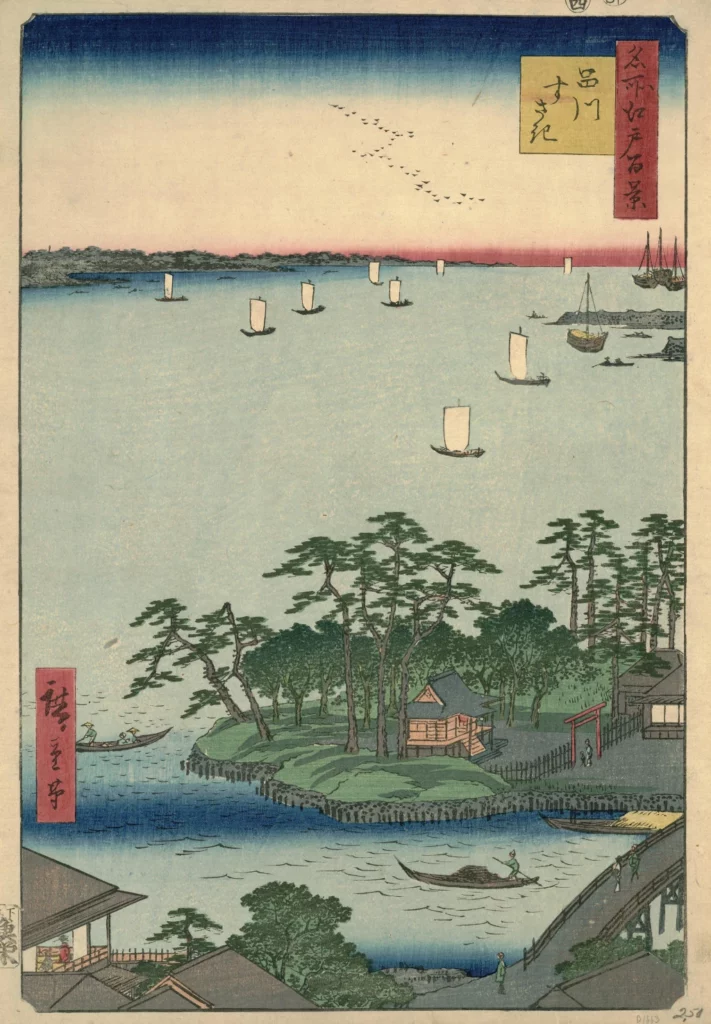🐋 Kagata Shrine – The Whale, the Shrine, and Edo’s Wildest Sighting
🌊 What is the Kagata Shrine and the Mound of a Whale?
Kagata Shrine is a small but historically rich shrine located near the mouth of the Meguro River. Just beside it stands a curious monument — a mound dedicated to a whale that washed ashore in 1798 and became a sensation across Edo, even reaching the Shogun himself.
⛩️ History of the Kagata Shrine
The area began to take shape in 1626 when a sandbank formed at the Meguro River’s mouth. Takuan, a monk from the famous Tōkai-ji Temple, established a small shrine called Susaki Benten-dō to worship the goddess Benzaiten.

As the area developed — particularly between 1774 and 1834 during the Shinagawa-juku era — the local Kagata family, who served as village heads (nanushi), led further expansions. The shrine and district came to be known as “Kagata.”
The main enshrined deity is Ichikishima-hime-no-mikoto (市板島姫命), a water goddess often associated with Benzaiten. Subshrines within the grounds include Kanazuchi Inari Jinja (金槌稲荷神社), devoted to prosperity and protection.
🪦 The Whale That Stopped Edo
On May 1, 1798, during a violent storm, a whale — likely a 16-meter-long Bryde’s whale — strayed into the shallow waters off Shinagawa. Local fishermen, who had never seen a whale before, feared they’d be shamed if it escaped. So they mobilized: banging boats, blowing conch shells, and shouting until they drove it aground at Tennōzu.
The whale couldn’t escape the sandbar and was captured. Crowds rushed from Edo and nearby villages to view it, paying high prices to rent fishermen’s boats. Some spectators reportedly called it “the whale of the century.”
🦢 The Shogun’s Whale
The story quickly reached Edo Castle. On May 3, a magistrate’s envoy arrived, and the Eleventh Shogun Tokugawa Ienari expressed interest in seeing it. The fishermen tied the whale to a boat and towed it to the sea off Hama Palace (now Hamarikyū Gardens), where Ienari watched in fascination for hours. As a reward, he gifted the fishermen a flag inscribed with 猟師町元浦 (Ryōshi Machi Motoura), meaning “Fishermen’s Town at the Old Inlet.”
After its tour, the whale returned to Shinagawa. It was dubbed “the Shogun’s Whale,” and merchants capitalized on the hype. Whale-themed snacks, books, and hand towels sold briskly, including satirical novels by Takizawa Bakin and Jippensha Ikku. One comic poem of the time read:
品川の沖にとまりしせみ鯨
みなみんみんと飛んでくるなり
Like a cicada, the whale flies in from Shinagawa Bay — buzzing with summer excitement.
🪨 A Whale’s Tomb
Eventually, the whale began to decay. Its bones were buried beside Kagata Shrine, and a stone mound was erected. On it is a haiku by Edo poet Tani Sōgai:
江戸に鳴る
冥加やたかし
なつ鯨
Edo ni Naru
Meika ya takashi
Natsu kujira
In Edo, the summer whale resounds, increasing the darkness”.
🙏 Shrine Details
Main Deity: Ichikishima-hime-no-mikoto (市板島姫命)
Subshrines: Kanazuchi Inari Jinja (金槌稲荷神社)
Affiliation: Local village shrine, originally part of Susaki Benten-dō
Annual Festival: Spring (date unconfirmed)
🧭 Visitor Information
Address: 1 Chome-2 Higashishinagawa, Shinagawa City, Tokyo 140-0002
Access: 6-minute walk from Kitashinagawa Station (Keikyū Line)
Best season: Late spring for festivals, summer for quiet visits
Admission: Free
Official Info: None
📍 Where is it?
| what3words | ///bliss.briefing.history |
| latitude longitude | 35.6195436 139.7415209 |
| Nearest station(s) | Kitashinagawa |
| Nearest public conveniences | Next to the whale memorial. |
🚩 Show me a sign

💬 Withervee says…
Records show that whales appeared again off Shinagawa in 1822 and 1851. The current monument — the Whale Tomb — is the only one that remains from the three famous animal-related Edo events: the Kyoho Elephant, the Kansei Whale, and the Bunka Camel. The whale event was widely celebrated, spawning art, satire, and consumer products, and forever linked Shinagawa to one of Japan’s earliest pop culture phenomena.
🌀 Site Character
- Solemn and contemplative
- Oddly poetic
- Smells faintly of history
- Ideal for a brief quiet pause
- Haiku-worthy atmosphere
👥 Who in their right mind would vote for this?
- Local Shinto followers
- Haiku lovers
- Marine biology nerds
- Fans of bizarre Edo legends
- Fans of pod casts
📚 Further reading
The whale incident is recorded in the Baiō Zuihitsu (梅翁随筆), a collection of rumors from the Kansei era (1789–1801), and in the Tokugawa Nikki. For literary works inspired by the whale event, see “Kyōgyo Shakuhin Kawa Haori” by Takizawa Bakin and “Ōgurei Fun Nengu” by Jippensha Ikku.

